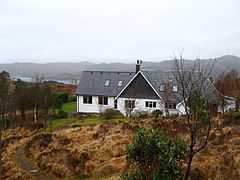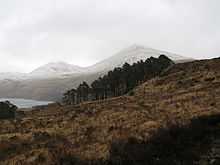Roshven
| Roshven | |
| Scottish Gaelic: Roisbheinn | |
 Marino Lodge |
|
 Roshven |
|
| OS grid reference | NM7078 |
|---|---|
| Civil parish | Arisaig and Moidart |
| Council area | Highland |
| Lieutenancy area | Inverness |
| Country | Scotland |
| Sovereign state | United Kingdom |
| Post town | LOCHAILORT |
| Postcode district | PH38 |
| Dialling code | 01687 |
| Police | Scottish |
| Fire | Scottish |
| Ambulance | Scottish |
| EU Parliament | Scotland |
| UK Parliament | Ross, Skye and Lochaber |
| Scottish Parliament | Skye, Lochaber and Badenoch |
Coordinates: 56°50′17″N 5°45′29″W / 56.838°N 5.758°W
Roshven (Scottish Gaelic: Roisbheinn) is a township located on the coast between the Sound of Arisaig and Loch Ailort, in Lochaber, in the council area of Highland, Scotland. Towering above it is Rois-bheinn, the highest hill in the area.
History

Historically, the hamlet was named Irine. According to the 1841 census, the main house by the burn was occupied by a Mary Anderson, originally from Kinlochailort.[1] In 1854, Jemima Blackburn, an artist, and her husband, Hugh Blackburn, Professor of mathematics at Glasgow University, bought the Roshven Estate, presumably from Anderson. Blackburn was noted for capturing the area's scenery, flora and fauna in her nationally-famous illustrations. She was particularly adept at painting birds and flowers.[2] Roshven Estate covers some 4500 acres. They subsequently renovated the Georgian house in the hamlet.[2] Their homes in Glasgow and at Roshven became a focus for visits from some of the most celebrated figures of the century including John Ruskin, Sir John Everet Millais, Anthony Trollope, the Duke of Argyll, Benjamin Disraeli, Lord Lister, Professor Helmholtz, Lord Kelvin and James Clerk-Maxwell, Jemima's first cousin.
On 12 January 1894, around 11.50 pm, the aftershock of an earthquake measuring 4 on the Richter scale was experienced at Roshven and the settlements of Arisaig and Glenmoidart.[3]
Geography and climate


Roshven is situated in the Highlands of Scotland, in the area of Lochaber. It lies on the southeastern bank of Loch Ailort along the A861 road, southwest of the settlement of Inverailort and east of Glenuig.[4] Boats can be moored in shallow water on the Loch near Roshven House.[5] At one time there were plans to build a terminal and a pier at Roshaven.[6] The area is mountainous, Rois-Bheinn being the highest and most dominant mountain, although Roshven is surrounded by other mountains such as An Stac, Sgurr Na Ba Glaise and Sgurr Dhomhuill Mor. The largest burn that comes through Roshven is the Irene Burn which originates in Lochan na Craoihhe and runs down past Roshven Farm and its estuary is located on the shore in front of the farm.
Roshven has quite a varied and unpredictable climate. Fort William which is located around 30 miles away experiences on average 3500-4500mm of rainfall every year. It experiences warm and wet summers and mild and wet winters. Snow is not very frequent because Roshven, like much of Lochaber, is subject to warm, moist air from the Gulf Stream.[7] According to the Royal Meteorological Society, one of the descendants of Hugh and Jemima Blackburn, Vera Philippa Blackburn (widow of William) who died in 1932, was keen on meteorology and had kept a rain gauge at Roshven in which she recorded the climate and rainfall for many years.[8]
Wildlife
Fauna
Many forms of wildlife are found at Roshven, both aquatic and land-based. In Loch Ailort there are many varieties of fish found such as mackerel, sea trout and salmon. Brown trout are also found in the burns and streams which run down off the surrounding hills. There have been occasional sitings of dolphins and whales in the loch, and once a whale died after being washed up onto the beach. Deer, foxes, wild cats, squirrels and pine martins are regularly seen in the area. The birds however are the major attraction of Roshven and this is what inspired Blackburn in her paintings. Golden eagles are often seen either flying over the loch or, more frequently, in front of the mountains and trees.
Flora

The vegetation growing at Roshven is lush, due to plentiful rainfall, but somewhat varied. One of the main plants is rhodendron, and trees such as Scots Pine, oak, birch and ash are common. Despite the rainfall, however, the land is not good for growing crops because the soil is thin, lacks fertility and can often be too inundated with water.
Economic and business
Tourism is important to the local economy. The Roshven Farm contains five chalets which are let out to visitors.[9] Deer stalking is carried out on the hills as well as hillwalking, fishing, sailing and rock climbing. Hill sheep farming is also practised and hay and silage are also grown on the lower, shore-bordering fields as these have thicker soils and can be used to produce food for cattle and sheep to feed on in the winter.
References
- ↑ Dickson, Joshua (9 October 2009). The Highland bagpipe: music, history, tradition. Ashgate Publishing, Ltd. p. 151. ISBN 978-0-7546-6669-1. Retrieved 2 February 2011.
- ↑ 2.0 2.1 Miers, Richenda (1 September 2006). Scotland's highlands & islands. New Holland Publishers. p. 117. ISBN 978-1-86011-340-6. Retrieved 2 February 2011.
- ↑ Davison, Charles (30 July 2009). A History of British Earthquakes. Cambridge University Press. p. 58. ISBN 978-0-521-14099-7. Retrieved 2 February 2011.
- ↑ Google Maps (Map). Google.
- ↑ Thomson, James; Larmor, Sir Joseph (1912). Collected papers in physics and engineering. University press. Retrieved 2 February 2011.
- ↑ Thomas, John; Paterson, Alan J. S. (1984). The West Highland Railway. D. St. John Thomas. p. 44. ISBN 978-0-946537-14-3. Retrieved 2 February 2011.
- ↑ "Climate and weather in Fort William and Lochaber". The Outdoor Capital of the UK. 2 February 2011.
- ↑ Glaisher, James (1933). Quarterly journal of the Royal Meteorological Society. Royal Meteorological Society. Retrieved 2 February 2011.
- ↑ "Chalets". Roshven.com. Retrieved 2 February 2011.